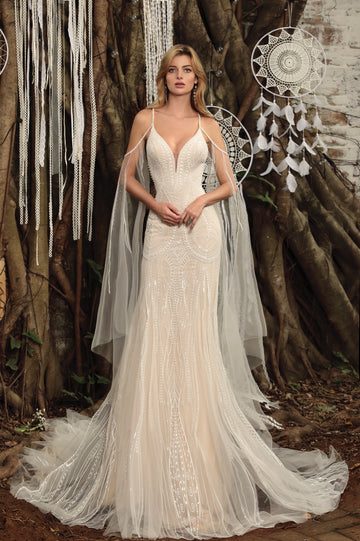Cultural Elements in Wedding Dress Aesthetics: An In-Depth Exploration
Cultural Elements in Wedding Dress Aesthetics: An In-Depth Exploration
Weddings are not just ceremonies; they are a rich amalgamation of traditions, beliefs, and cultural elements that shape every aspect of the event, especially the wedding dress. The aesthetics of wedding dresses vary significantly across different cultures, and understanding these cultural elements offers insights into the meanings and symbolism behind wedding attire. In this article, we will explore the cultural elements in wedding dress aesthetics, their significance, and how they evolve over time.
The Importance of Wedding Dresses in Different Cultures
The wedding dress is often the centerpiece of a wedding, symbolizing love, purity, and commitment. Different cultures have their unique styles and elements, influenced by historical, social, and religious factors. Let's take a closer look at some key cultural elements found in wedding dress aesthetics.
1. Color Symbolism
Color plays a crucial role in wedding dress aesthetics around the world.
| Culture | Common Color | Symbolism |
| Western | White | Purity and Innocence |
| Chinese | Red | Good Luck and Happiness |
| Indian | Red, Gold | Prosperity and Fertility |
| Japanese | White | Purity, followed by colorful kimono |
In Western cultures, white dresses symbolize purity and innocence, while in Chinese culture, red signifies good fortune and happiness. Indian wedding dresses are often vibrant with colors like red and gold, representing prosperity and fertility. In Japan, the traditional wedding attire moves from white to colorful kimono, showcasing the journey of the bride.
2. Fabric Choices
Fabric choice is another cultural element that reflects the aesthetics of wedding dresses.
In Western cultures, luxurious fabrics such as silk, satin, and lace are commonly used for wedding dresses, symbolizing elegance. In contrast, Indian brides often wear intricately designed sarees or lehengas, crafted from heavy silk or brocade, reflecting their cultural heritage and craftsmanship. Meanwhile, Chinese weddings may feature embroidered silk dresses known as qipao, which represent tradition and formality.
3. Design and Embellishments
The design of a wedding dress is heavily influenced by cultural aesthetics.
In Western societies, styles can range from classic ball gowns to modern minimalist designs, often adorned with lace, beads, and embroidery. In South Asian cultures, embellishments are vital; intricate handwork, mirror work, and embellishments such as zardozi are common in traditional garments. African wedding dresses may feature vibrant patterns, bold colors, and unique designs representing the bride's ethnic background and social status.

Understanding these design elements provides a glimpse into the bride's identity, heritage, and personal story.
4. Jewelry and Accessories
Jewelry also plays a significant role in the wedding attire across various cultures.
In India, brides wear heavy gold jewelry, including necklaces, earrings, and headpieces, symbolizing wealth and status. In Western cultures, brides often opt for simpler designs, such as diamond or pearl necklaces and earrings to complement their dress. Some African cultures feature unique headpieces or crowns as part of their wedding attire, symbolizing royal status and cultural pride.
Evolving Trends in Wedding Dress Aesthetics
As society evolves, so do the trends surrounding wedding dresses. Globalization has led to a fusion of styles, where brides incorporate elements from various cultures into their wedding attire.
For instance, many modern brides opt for a mix of traditional and contemporary styles, such as wearing a white Western-style dress for the ceremony and changing into a vibrant, intricately designed outfit for the reception. The integration of cultural elements in wedding dress aesthetics not only honors tradition but also reflects individuality and personal expression.
1. Eco-Friendly Choices
With the growing awareness of sustainable fashion, many brides are now opting for eco-friendly wedding dresses made from organic fabrics or vintage gowns. This choice showcases a blend of cultural acknowledgment and a commitment to environmental sustainability.
2. Gender-Neutral Styles
The shift toward inclusivity has also influenced wedding dress aesthetics. Many couples now choose attire that celebrates their identities and personal preferences, irrespective of traditional gender norms. This can include tailored suits, colorful dresses that defy stereotypes, or even fashion collaborations that pull from various cultural influences.
Common Questions about Cultural Elements in Wedding Dress Aesthetics
As we delve deeper into wedding dress aesthetics, several common inquiries arise:
- What is the significance of color in wedding dresses across cultures? Different colors symbolize various meanings and values specific to each culture. For example, red is associated with luck in Chinese weddings.
- How do cultural elements influence modern wedding dress trends? Contemporary brides often blend traditional and modern elements, celebrating their heritage while expressing individuality.
- What are some common fabrics used in wedding dresses around the world? Fabrics range from lace and silk in Western weddings to heavy brocades and silk in Indian attire.
Conclusion: Embracing Diversity in Wedding Dress Aesthetics
Cultural elements in wedding dress aesthetics provide a profound understanding of cultural heritage, identity, and values. As weddings continue to evolve, embracing these elements can lead to the creation of a unique and meaningful celebration. Whether you choose to honor tradition or pursue a more contemporary and personal approach, it's essential to respect and appreciate the rich tapestry of cultural influences that shape wedding dress aesthetics.
When choosing a wedding dress or attending a wedding, consider the cultural significance behind the attire, and embrace the diversity it brings to the celebration. By understanding and recognizing these elements, we not only appreciate the individual stories they tell but also contribute to the global celebration of love and unity.
